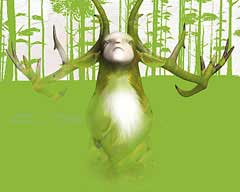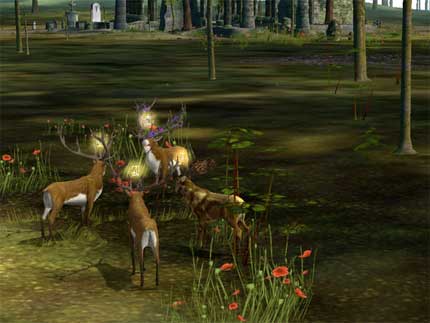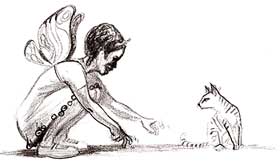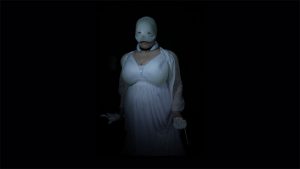 The Endless Forest is a MMORPG where everyone plays a deer. And no, the aim is not to shoot other deers. There’s no violence, no particular rule to follow, neither does the game feature any chat-functions. All communication happens through deer-body-language. You can roar, sniff other deers, eat mushrooms from the trees, pick up and carry flowers on your antler, etc. Players do not even get “proper” names, but pictograms that represent their characters.
The Endless Forest is a MMORPG where everyone plays a deer. And no, the aim is not to shoot other deers. There’s no violence, no particular rule to follow, neither does the game feature any chat-functions. All communication happens through deer-body-language. You can roar, sniff other deers, eat mushrooms from the trees, pick up and carry flowers on your antler, etc. Players do not even get “proper” names, but pictograms that represent their characters.
The setting is idyllic, the forest is peaceful, you can wander along the Pond or have a nap by the Old Oak Tree.
The project is being developed in phases. Each of them is influence by the feedbacks from the players, who contribute ideas on the game’s forum.
One of the most recent features of the game is called Abiogenesis (the generation of life from non-living matter). It allows the authors of the game, Auriea Harvey and Michaël Samyn, to play god in their virtual universe by controlling the weather, and all sorts of flying and non-flying objects and beasts. The Twin Gods might also invite everyone to come to a certain place at a given time to enjoy a live spectacle performed by the deities themselves. In April Phase Two of the game was released: the play space is much bigger and the amount of possible activities has increased as well. The most significant addition is the introduction of magical powers that allow players to transform the appearance of others.
The Endless Forest has been developed by game company Tale of Tales, founded by former Internet artists Auriea Harvey and Michael Samyn. When i first read about the game last year, i found this idea of a jeu d’auteur extremely interesting. I had to read in three different sources that they are from Belgium before believing it (so is the faith i have in my own country!) Auriea Harvey and Michael Samyn were an enigma to me so i thought i should interview them. I’m not sure i’ve managed to make them less mysterious but at least i’ve tried!
What is your background?
We used to be world famous web designers and net.artists! We have made hundreds of projects as Entropy8Zuper!, some commercial commissions, others art pieces.
There had always been a playful element in our work but it wasn’t until we became disenchanted with the web a few years ago that we turned to realtime 3D as a medium for our work.
I read that you’re planning to add many things to The Endless Forest. “Some may indeed be slightly game-like while others simply pretty or poetic.” Can you tell us more about the next updates of the game? What’s your priority: making the experience more game-like or more poetic?
We haven’t decided what we are going to choose to make first in Phase Three but, we will introduce a few smaller additions. All of these will be more poetic than game-like. Our priority if definitely with poetry. To some extent we only use game-type interactions to stimulate people to hang out in the world a bit longer. Ideally, however, we want to design interactions that are poetic in and of themselves. We don’t think games are the only form of interaction possible in realtime 3D. In fact, in our opinion games are somewhat of an outdated form of interaction now that the technology has evolved to allow much more variation.
 Many people have worked on the Endless Forest. How long did it take to develop the game?
Many people have worked on the Endless Forest. How long did it take to develop the game?
Most of the work has been done by the two of us. But then Lina Kusaite has designed the stag avatar, Ringtail Studios modelled and textured it and Laura Smith animated it. Gerry De Mol made the music and Jan Verschoren the sound effects. And Ronald Jones designed de blueprint for our engine. That’s a very small group to be working on a game. And we like it that way.
The first prototype of the game was made in June 2004 with just us two, but we started remaking the thing with the team in May 2005. The first public release happened in September 2005. Then we continued working on it until April 2006 when we released Phase Two. So it took about a year in total, so far.
Do you play other video games? Which ones?
We try a lot of games but only very few stick. We have been playing Animal Crossing for almost a year. We like to replay the original Black & White once in a while. We have enjoyed Ico, of course, and are fans of Silent Hill and Fatal Frame/Project Zero. Sometimes we enjoy fighting each other in Tekken or Soul Calibur. And we’ve been known to spend long nights in Neverwinter Nights and Guild Wars as well. And a last one of our favorites is an old CD rom game called Ceremony of Innocence. It was made by Alex Mayhew at Peter Gabriel’s studios back in the day. It’s a really lovely romantic story based on a book by Nick Bantock.
What was the motivation of the Endless Forest? Did you feel there was a need for alternative computer games?
Our motivation to make computer games the way that we do, stems from the fact that we enjoy certain aspects of commercial computer games a lot, but dislike others with a passion. So we try to make computer games without all the things that we don’t like (competition, meaningless violence, strict rules, predefined goals, canned stories). We also try to add a certain level of authorship that we feel is lacking in commercial games. They often feel too much like products that fell off an assembly line in some toy factory than deepfelt expressions of creative people.
The Endless Forest in particular was motivated by a desire to create a peaceful social environment. Online games very often seem like dressed up single player games. We try to design interactions that invite playing with each other. We also consciously removed all ways in which players could hurt or annoy each other. That’s why there is no chat in the game, for instance.
Are you working on other projects?
 Yes. Next to smaller additions to The Endless Forest, we’re working on three other projects. The first is our last net.art piece, the fifth chapter of Entropy8Zuper‘s Godlove Museum, called Deuteronomy.
Yes. Next to smaller additions to The Endless Forest, we’re working on three other projects. The first is our last net.art piece, the fifth chapter of Entropy8Zuper‘s Godlove Museum, called Deuteronomy.
The other two projects are related to each other. One is a research project called Drama Princess, the other a game called 144. Drama Princess is an attempt to build a software system that should help us populate our games with autonomous characters. We’re maintaining a development journal about this project on http://Tale-of-Tales.com/DramaPrincess. 144 is a short horror game based on older versions of the folk tale of Little Red Ridinghood. 144 is a “spiritual sequel” to 8, our first game design, which was based on Sleeping Beauty.
How was your work received by the various communities? Does the traditional video game scene welcomes it with as much enthousiasm as the art scene?
We were actually surprised by the amount of positive feedback we have received from computer game players. While, as expected, there is definitely a large amount of hardcore gamers who don’t get The Endless Forest at all -and who seem to feel strangely threatened by it-, we have received a lot of positive comments from both games press and players. I would even say that the games people who find out about the game often express more enthusiasm than the art lovers. It seems like, for many people, The Endless Forest is something they’ve been waiting for.On the art scene, our work is at least as odd as on the game scene. But there also, many people welcome the warm simplicity and pleasant “humanness” of the game with open arms in an environment that is usually full or ironic, if not cynical, “clever” and cold conceptual pieces.
Do you feel that your work belong to fine art or to digital art? But should we make a distinction between fine art and computer-based art forms, like many do?
I’m actually not sure what you mean by “digital art”. There is a growingamount of computer-based art that is included in contemporary fine arts. But most of it is as stale and snobbish as its analog brothers and sisters. In de mid-nineties we fled the world of galleries and museums as well as the world of pop culture, to find a beautiful place on the internet where creative people could share their work with the audience directly and without mediation. We still work in this mindset. We prefer to offer our work straight to the spectators, without any kind of framework. I think we do think of our work mostly as games and not so much as art, but in the sense that art film makers consider their work to be cinema first and foremost. We have a similar attitude: we make games, yes, but they are artistically more interesting than most commercial games. This doesn’t stop us from mparticipating in art events though. The Endless Forest will be featured in Steve Dietz‘s Edge Conditions in California, in Furtherfield’s Game/Play in the UK and in Rasa’s “Pixel Me” here in Belgium. I daresay, it’s probably the only computer game that has been in so many art shows.
 Sorry i can’t avoid this question. You’re from Belgium. Being myself from the rather “vintage” French-speaking part of the country, i have always felt a bit of envy towards the dynamism and creativity of the Flamish region. How is the game and the digital art scene there? Is there a big community, many events or instituttions that give visibility to your work?
Sorry i can’t avoid this question. You’re from Belgium. Being myself from the rather “vintage” French-speaking part of the country, i have always felt a bit of envy towards the dynamism and creativity of the Flamish region. How is the game and the digital art scene there? Is there a big community, many events or instituttions that give visibility to your work?
Both the games community and the digital art scene are very small in Belgium. But coincidentally, both are trying to organise themselves am bit these days. So they are growing.
We don’t know much about the games industry here, really, but it seems like the digital art scene is doing slightly better. The bigger Flemish cultural centers are -finally- making digital media art part of their programme with festivals and lectures. These are mostly theaters. The museums still seem to be a bit shy.
Even “dynamic Flanders” is slow, though. It seems like a lot of artists here are still stuck in some ancient video-art practice. Sure, they use computers now, but they’re still projecting stuff on walls. And it looks and sounds like abstract gibberish most of the time. Others are only in Belgium by coincidence, really, and work very internationally. But something is definitely moving and growing at the moment. It’s great to be part of that. To some extent, the conservatism of Belgium can work in our advantage. The fact that we are growing slowly into digital art will also mean that it’s presence will be much more solid. The conservatism works both ways.
Any Belgian artists you think should get more attention from the public?
Our friends at Foam do excellent work with mixed-reality environments, new materials, responsive installations and even food. Another favourite is Lawrence Malstaf. He also (re-)introduces the human element in technological art, often in a very poetic way.
Thanks Michael & Auriea!
The game can be downloaded for free. Go on, just “steer your deer through the forest and see what happens.”







